Basic Information & Functions
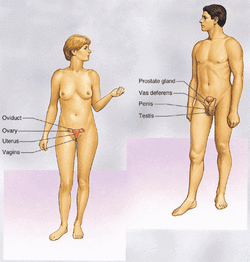
The male and female reproducitve systems differ greatly because they have very different functions. The male reproductive serves to create sperm. Sperm carries an "X" or "Y" chromosome that determines the sex of a fetus when it meets an egg. It also carries 23 of the father's chromosomes. The egg is produced by the female. Once the egg is fertilized, it will begin to grow insdie the woman's uterus. The egg contains 23 sets of the woman's chromosomes. When the two unite in the woman, the offspring gets all 46 chromosomes, 2 sets of 23, that it needs. These chromosomes carry genetic information in the form of DNA. The reproductive system also emcompasses the glands that secrete the horomones that give rise to secondary sex characteristics. Without these items, neither you nor I would exist!
Male Reprodcutive System
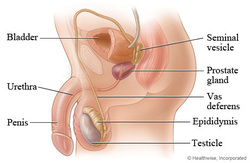
The testes are two glands that produce horomones, including testosterone, and sperm. They are located in the scortum which hangs outside, below the pelvis. As soon as a male reaches puberty, his testes begin forming sprem cells. The epididymis is where immature sperm cells are stored until they reach maturation. They are the transported to 18 inch long, muscular tubes called the vas deferens. Contractions of the vas defernes force sperm into the urethra. The urethra is wehre urine and sperm exit the male body. The two seminal vesicle secret a liquid with fructose sugar just before the sperm reach the ejaculatroy duct. The prostate gland adds a milky, alkaline substance called prostatic fluid. Cowper's glands add mucus. These liquids mix to form what is known as semen. The semen then exits through the urethral opening at the end of the penis in a porcess called ejaculation. One ejaculation may contain millions of sperm.
The Life of a Sperm Cell
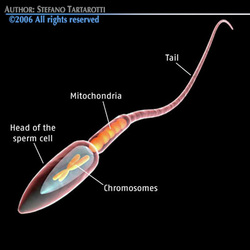
Inside the testes there are structures called seminiferous tubules. It is inside these tubules that sperm are actually made. The edididymis lies on top of theses tubules. Once the sperm cell has been formed, it travels into the epipydidymis. Sperm stay there, fertile, for up to six weeks. As yhe man and hardens, the sperm prepare to be ejaculated. The sperm in the epipydidmys are pushed into tubes called the vas deferens. They then enter into the ejaculatory ducts. They then mix with the aforemention fluids to create semen. The liquid with the sperm is the propelled forward through the urethra. It then exits the body and into the vagina of the female. The sperm then travel up through the vagina, cervix and uterus to fertilize an egg in the fallopian tubes. The sperm have 12-48 hours to to so or they will die without fertilizing an egg.
Female Reproductive Sysytem Cell
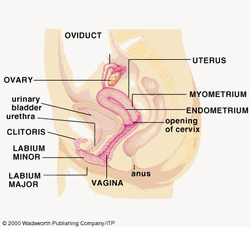
The female reproductive system begins with the ovaries. They produce the horomones estrogen and progesterone. They also produce egg cells called ova. Next are two four-inch tubes name fallopian tubes. They are lined with ciliated cells and lead intot he womb or uterus. The uterus is pear shaped and about 3 inches long. Inside, it is lined with the endometrium. The endometrium sheds itself and begins to rebuild in accordance with the menstrual cycle if an egg is not fertilized. If a fertilization were to occur, the fertilized egg would implant intself into the endometrium. The cervix is located at the end of the uterus and joins it to the vagina. The vagina is a musuclar tube that leads to the external opening. The outside genitilia of a woman is called the vulva. It is important to note that females have a seperate opening for the urethra that is located above the vaginal opening.
The Life of an Egg
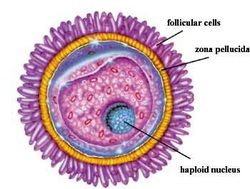
Each month, an ovary releases a matured egg from an ovary into an open fallopian tube. Immature eggs cells are called oocytes. A woman is born with wall the oocytes she will have for her entire lifetime. This is usually about 30,000. The cycle of menstruation, or released an egg so it can be ertilized, begins around age 12. They cycle starts wehn a follicle begins to grow inside of the ovaries. Follicles are developing egg cells surrounded by a layer of surrounding cells. The follicle grows for about 13 days inside the ovary and releases estrogen. The follicle, stimulated by horomes, grows rapidly and ruptures. The egg is released from the follicle and enters the fallopian tubes. The ends that open near the ovary are called fimbriae. They are wavy because they sweep the egg into the fallopian tube. The egg than travels down the fallopian tube and into the uterus. If the gg is not fertilized within 12 to 24 horus after release, it will stop developing and dissovle before it reaches the uterus. The woman then sheds her endometrium and the cycle begins anew. If the egg is fertilized, it is transported by the cilia in the fallopian tubes and implanted in the endometrium where it begins to grown and develop into an offspring.
Images Cited
http://163.16.28.248/bio/activelearner/37/ch37c10.html
https://members.kaiserpermanente.org/kpweb/healthency.do?hwid=hw143376§ionId=hw143376-sec&contextId=hw7265
http://www.exchange3d.com/3D%20Model%20of%20Sperm%20cell%20with%20internal%20parts/prod_5851.html
http://www.sci.sdsu.edu/classes/bio100/Lectures/Lect18/lect18.html
http://bhavanajagat.wordpress.com/
https://members.kaiserpermanente.org/kpweb/healthency.do?hwid=hw143376§ionId=hw143376-sec&contextId=hw7265
http://www.exchange3d.com/3D%20Model%20of%20Sperm%20cell%20with%20internal%20parts/prod_5851.html
http://www.sci.sdsu.edu/classes/bio100/Lectures/Lect18/lect18.html
http://bhavanajagat.wordpress.com/
